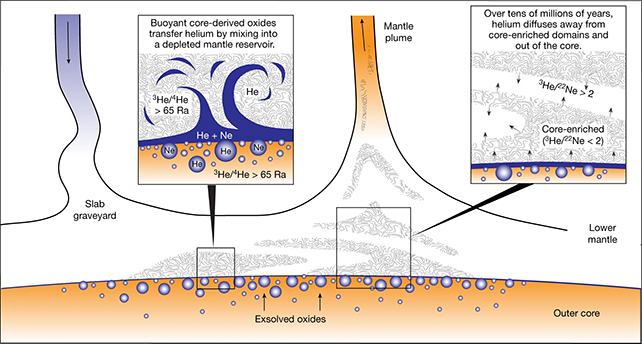Record concentrations of a helium isotope found inside 62-million-year-old Arctic rocks could be the most compelling evidence to date of a slow leak in our planet's core.
Building on the results of a previous analysis of ancient lava flows, a team of geochemists from Woods Hole Oceanographic Institution and the California Institute of Technology are now more certain than ever that helium trapped in the core as our planet was forming is making its way to the surface.
Helium isn't the kind of element that makes friends easily. Being so light and non-reactive, there's little to stop the gas from diffusing out of exposed rocks into the atmosphere and drifting off into space.
That makes helium a surprisingly rare material on the planet's surface. Yet just how much of the element remains trapped deep beneath our feet is one of the great unknowns in geology.
After around 4.6 billion years of spitting lava, most of the helium Earth swallowed as an infant should have been burped away. So any traces of the gas found in relatively fresh deliveries of volcanic rock ought to have come from pockets of mantle that are yet to cough up their helium, or from a slow-leaking reserve.
Basaltic lavas on Canada's Baffin Island contain some of the world's highest ratios of helium 3 (3He) to the slightly heavier isotope, helium 4 (4He). To geologists, such a mix indicates the gas's presence isn't contamination by the atmosphere, but rather a sign of deeper, more ancient origins.
Several years ago, Woods Hole Oceanographic Institution geochemist Forrest Horton uncovered helium isotope ratios of up to 50 times that of atmospheric levels in samples of olivine collected from Baffin's lava fields, making them high even for the mantle.
This unusual concentration of 3He was also present in lavas collected from Iceland, on a section of crust thought to sit above its own, distinct conveyer belt of mantle activity.
Without ruling out the possibility of a coincidence, Horton and his team wondered if both hotspots may have received their helium from an ancient reservoir adjacent to the mantle.
It now seems their hunch might be correct. Their latest analysis including a collection of olivine taken from dozens of sheltered sites across Baffin and surrounding islands has delivered the highest ratio of 3He to 4He ever recorded in volcanic rock, measuring nearly 70 times anything seen in the atmosphere.
By also taking into account ratios of other isotopes, including strontium and neodymium, the team could rule out factors that may have altered the helium's identity post-eruption, building an even stronger case for the gas's unusual origins.

A measure of the ratio of isotopes of another noble gas, neon, also matches the conditions present when Earth was being pieced together billions of years ago, pointing to a vault time has all but forgotten.
Tracing the neon and helium back to the core isn't as wild as it might first seem. Simulations on the thermodynamics, pressures, and composition of our planet's guts suggest reserves of noble gases trapped in the core could have been protected as Earth grew, only to seep into the surrounding mantle over time.
Hidden behind thousands of kilometers of dense, hot rock, Earth's core is about as inaccessible as an object gets in science. Our only means of studying it is by listening carefully to the way our planet echoes beneath its skin.
If it does leak, we might have one more way to study its processes, and learn a thing or two about the way planets like our own come together from a swirl of dust and primordial gas.
This research was published in Nature.
